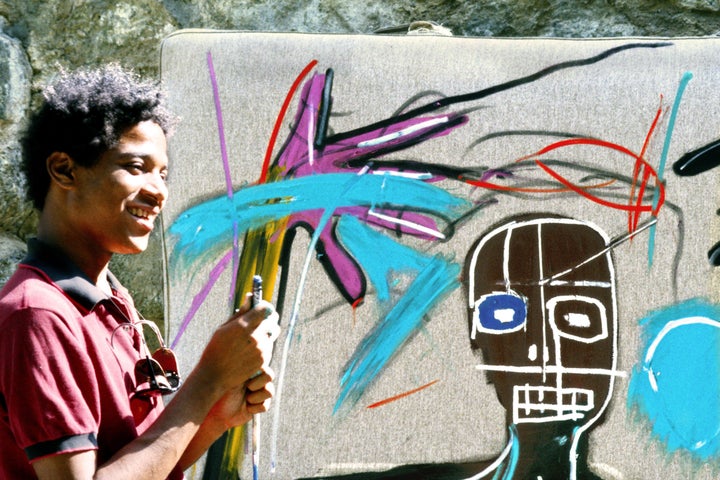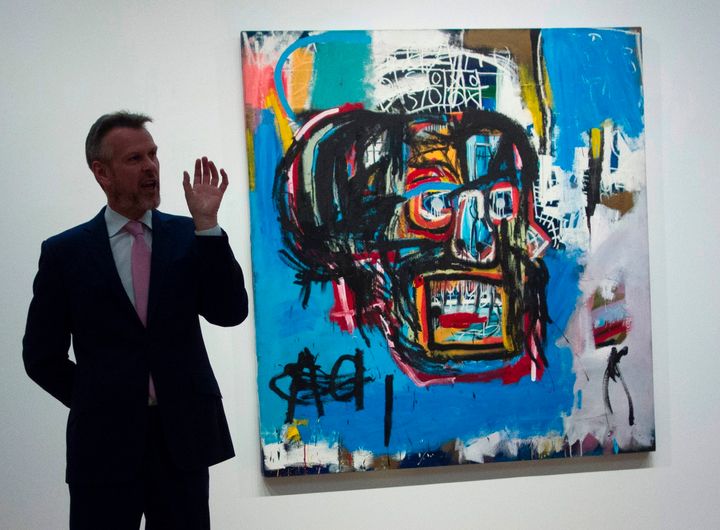
Jean-Michel Basquiat, hailed as the first black art star to break through New York’s predominantly white gallery world, made history on Thursday when his untitled painting sold for a heart-stopping $110.5 million. After the record Sotheby’s sale, the late Basquiat ― who died at age 27 in August 1988, in the midst of a meteoric career ― officially became the highest selling American artist at auction.
Born in Brooklyn in 1960, Basquiat has often been described in terms of what he was and what he managed to become ― long before he dethroned Andy Warhol as America’s most expensive maker of art. “How did a young graffiti rebel go from selling drawings for $50 in 1980 to having a painting come up for auction this week at a staggering $60 million?” The New York Times asked ahead of the May 18 sale.
Even when he was alive, critics gawked at his rise from homelessness and unemployment to unfathomable celebrity status, selling single paintings for five figures when he was just 24 years old. The artist himself spoke openly of his fractured past, of the domestic abuse he experienced as a child at the hands of his Haitian father or the bouts of mental illness suffered by his Puerto Rican mother. He was exposed to art and foreign languages at a young age (he was famously fluent in French, Spanish and English), excelling at both, but as a teen he ran away from home and dropped out of high school.
He was reportedly selling T-shirts and postcards on the street shortly before he and a friend adopted the shared pseudonym SAMO, spreading their graffiti tag across SoHo ― a neighborhood flush with the galleries and gallerists they needed to take notice. This technique was how Basquiat rose: by making his work impossible to miss.
Basquiat painted his $110.5 million painting when he was just 22 years old. By then, he’d already scrawled “SAMO IS DEAD” on a wall in lower Manhattan, announcing the end of the collaboration that first brought him to New York’s attention. He’d already gone to lengths to rub elbows with artists, writers and other fixtures of the era ― Warhol, “TV Party” host Glenn O’Brien, Blondie, David Bowie, art dealer Larry Gagosian. He’d already brought his explosive body of work ― a punkish blend of Neo-expressionism and primitivism that involved wild colors, manic brushstrokes and skeleton-like faces and bodies ― into galleries for critically acclaimed solo shows. His art (thousands of paintings and drawings), his words, his body, even his hair, soon became part of the very bedrock of pop culture at the time.
O’Brien, who wrote the film, “Downtown 81,” starring Basquiat, put his popularity in perspective: “Basquiat’s got fans like Bob Marley’s got fans.”
His ascent to art stardom was swift, but decades after his death, Basquiat’s legacy is much grander; the undeniable impact he had on the art world is more impressive than his quick ability to infiltrate it. He worked tirelessly in those few years, performing and networking and making art, to ensure that his vision was acknowledged ― a vision that involved bright condemnations of America’s racist past and its history of police brutality, as well as celebrations of black heroes and events otherwise missing from gallery walls. He used reclaimed materials and graffiti techniques to wedge politics into these pristine spaces.
One work in particular, “Defacement (The Death of Michael Stewart),” memorialized the death of a black graffiti artist who was beaten to death by New York City police. “It could have been me,” Basquiat said, in a phrase that reverberates now. “It could have been me.”

Before he died of a heroin overdose, Basquiat maintained complicated relationships with the segregated art world illuminated in his obituaries. “Ultimately, Basquiat would be the only black artist to survive the graffiti label, and find a permanent place as a black painter in a white art world,” one reads. Today, his place in that world is often used as a prism through which we can view the contemporary art establishment ― how it’s changed and how it hasn’t.
“There was no not seeing Basquiat. He was everywhere and made sure everyone saw him,” Jordan Casteel told The Guardian. “Today it is going to be the same, there is no not seeing. You will see us. We as black artists will continue to fight for that visibility, and we can do that, but, it is also going to mean that the ‘mainstream’ art world has to accept that there are more than a few and there is some true talent out there.”
Nearly 30 years after his death, Basquiat’s work, and his work ethic, are far from being forgotten. He’s bested Warhol, posthumously exceeding the auction prices of other “quintessentially American” (read: white and male) artists like Jackson Pollock, Mark Rothko and Robert Rauschenberg. While Warhol’s pop art embraced the sheen of consumerism, allowing wealthy buyers to feel like they were in on his jokes, Basquiat’s violent canvases critiqued power, colonialism and class conflict, rarely letting viewers who really looked off the hook.
The art market and the institutions that support it have a long way to go in terms of inclusion ― and, in many ways, they provide a fun-house reflection of the U.S. and its slow work toward the same thing. But it the meantime, the market has crowned Basquiat as the ultimate American artist, and for that, we’re thankful.
CORRECTION: A previous version of this article misstated Basquiat’s year of death as 1998; he died in 1988.

